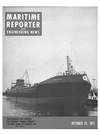
Page 21: of Maritime Reporter Magazine (October 15, 1971)
Read this page in Pdf, Flash or Html5 edition of October 15, 1971 Maritime Reporter Magazine
Shipbuilders Council
Supports U.S. Ships
For LNG Importation
In connection with increasing pros- pects for utilization of foreign source liquefied natural gas (LNG) to satis- fy the nation's energy deficiencies, the board of directors of the Ship- builders Council of America at its recent quarterly meeting unanimously agreed on advocacy and support of the following goals: 1. A declaration of national policy favoring the importation of LNG, where necessary, in American-built vessels. 2. A show of evidence of the indus- try's capability to produce LNG car- riers in increasing numbers to meet expanding requirements. 3. A series of public statements demonstrating that the technology of
LNG transportation and the state of the art of shipbuilding minimize ecological risks. 4. A pronouncement of Adminis- tration intentions to make construc- tion subsidy funds and Title XI
Mortgage Insurance Guarantees, plus other provisions of the Merchant Ma- rine Act of 1970, available for LNG carriers. 5. A continuing effort to ensure that the provisions of the Jones Act are applicable to LNG barges and vessels for noncontiguous, intercoast- al, coastwise or interstate services. 6. A series of presentations, as in- terveners, before the Federal Power
Commission by the Maritime Admin- istration and any other interested parties on behalf of continued utiliza- tion of American-built vessels for the importation of LNG in those cases
Almost three football fields long, with a 36,000 hp power plant, this ship will go 20 knots.
Flexible design permits carrying barges, 1,800 containers, or a vast roll-on, roll-off cargo.
Ship can be used as a military sealift vessel for troops, tanks, wheeled vehicles, helicopters, landing craft, containers and palletized cargo.
The Seabee concept makes shallow harbors and inland waterways an integral part of a global sea transportation system.
The great advantage of the
Seabee's open-deck arrange- ment is the unique cargo- handling flexibility it makes possible.
It can accommodate barges.
Or stowage of 1,800 20-foot containers on trays, twice as many as even the latest cargo ships can normally handle.
Or vehicles that can be rolled on and off over almost 3V2 miles of single-lane "high- way" covering a staggering 146,000 square feet of deck.
Or such a cargo as an assem- bled oil rig could be stowed on upper deck space free of over- head restriction.
And helicopters, including the huge Skycrane, can be flown from the upper deck.
This flexibility uniquely quali- fies the Seabee for military sealift use, as well as commer- cial transport.
Building a ship with this much potential for saving time and money for owner and shipper alike called for radically new concepts in engineering and construction. But at General
Dynamics, it seems our people are always doing something that hasn't been done before.
GENERAL DYNAMICS
By eliminating dockside handling, loading time can be cut from over a week to just 13 hours.
From the elevator, two self- propelled transporters move the barges into place in a fore- and-aft position on three un- obstructed decks that stretch the entire length of the ship's cargo space. where water transport is involved.
Regarding points one and six above, the Council's board took a positive stand favoring importation of all
LNG by American-built ships and cited the changing nature of the bal- ance of payments problem as justi- fication.
Newport Ship Yard
Awarded Army Contract
Newport Ship Yard, Inc., New- port, R.I., has been awarded a con- tract by the U.S. Army Mobility
Equipment Research and Develop- ment Center at Fort Belvoir, Va.
The contract, valued at approxi- mately $25,000, calls for the design, fabrication, and testing of a 26-foot bridge erection boat. The vessel is a prototype craft to be of welded aluminum, diesel powered, and de- signed for shallow draft mobility.
Construction will be such that the vessel can be carried on a trailer over rough terrain.
The contradt is the first of its type for Newport Ship Yard in that the firm will be responsible for the original design concept, com- plete manufacture, and testing. De- sign activity will be coordinated by staff members of J.J. Henry
Co., Inc., naval architects of
Moorestown, N.J. Delivery of the boat is scheduled for early 1972, following sea trials at Newport.
It will be built in the yard's new 7,200-square-foot fabrication cen- ter.
In a joint statement, president
Neil C. Peirson and vice president
Michael E. Collins said that this contract award represents a con- tinuing growth of the firm into ad- ditional areas of marine industrial activity, and that it is a significant step in expanding capabilities of the Newport Ship Yard.
New York Navigation
Opens Houston Office
New York Navigation Company
Inc., which specializes in serving the oil industry, has opened an office at 3200 Travis Street in
Houston, Texas. The office is headed by Robert L. Easton, vice president.
New York Navigation Company is a major contractor for overseas shipping of oil rigs, extra heavy lift cargoes, pipelines and refiner- ies, both for import and export, for the oil, engineering and con- struction trades.
In opening the Houston office,
New York Navigation Company stated it fel't Houston gave the most central location in view of the increasing concentration of traffic personnel for the oil related industries in the Southwestern area of the United States, espe- cially for the Louisiana-Texas Gulf
Coast shippers.
New York Navigation Company, with headquarters in New York
City, also has offices in London,
Rotterdam, Hamburg, and Ma- drid. Biehl & Co. will serve as steamship agents for the firm in the Gulf Coast area.
October 15, 1971 25

 20
20

 22
22
